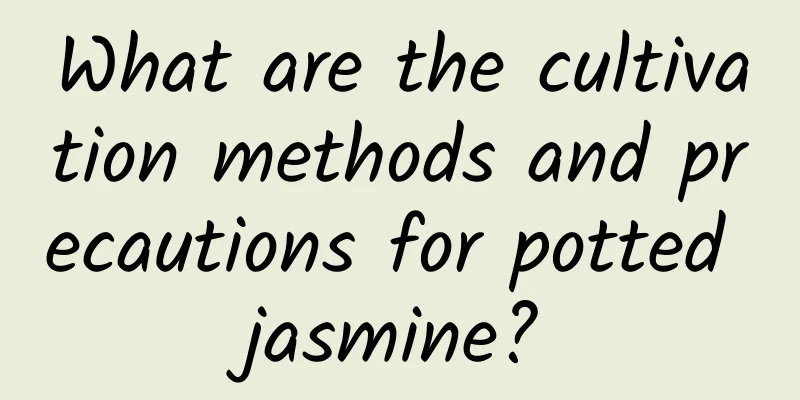What are the cultivation methods and precautions for potted jasmine?

Jasmine growth habitsJasmine likes a warm, humid environment with plenty of sunshine. Its leaves are emerald green, its flowers are white, and it has a strong fragrance. Most varieties bloom from June to October. It is highly ornamental and suitable for growing at home. The methods of propagating jasmine include cuttings, layering, and division. How to grow potted jasminePotted jasmine prefers a warm, humid, well-ventilated semi-shady environment. It is suitable for planting in slightly acidic sandy loam rich in humus. It is not cold-resistant. If the temperature is lower than 3 degrees in winter, the branches and leaves are prone to frost damage. If it lasts for a long time, it will die. It is not tolerant to waterlogging. Watering methodJasmine should be watered according to the principle of not watering unless the soil is dry, and making sure to water thoroughly when watering. In spring and autumn, it is generally watered once every 2 to 3 days, and can be sprayed once a day. In summer, it is sprayed twice a day. In winter, the amount of watering should be reduced in the greenhouse, otherwise the roots will easily rot. Fertilization methodJasmine likes fertilizer. After moving it out of the room in spring, you can water it with some dilute alum fertilizer water. As the weather temperature rises, the plant's growth potential increases and the demand for fertilizer increases. Fertilizer can be applied in time. Phosphorus and potassium fertilizers can be applied before flowering. Stop applying fertilizer during the peak flowering period and stop fertilizing after bringing it indoors in winter. Pruning methodsJasmine can be pruned in spring, mainly by cutting off dense branches, dry branches, diseased branches, crossed branches, etc., and cutting the overgrown branches short to promote the growth of new branches, which is beneficial to flowering. In addition, after the flower buds bloom in spring, some of them can be thinned out. After the flowers fade, the remaining flowers should be removed in time to promote the next flowering. Precautions for potted jasmine cultivationPotted jasmine likes high temperatures, but it cannot be exposed to direct sunlight in the high summer temperatures. In addition, it also likes a humid environment. Generally, when the soil moisture content is around 60%, it is beneficial to the growth of the plant roots. However, jasmine avoids water accumulation. If the soil is too moist, it will cause root rot. |
<<: What are the cultivation methods and precautions of Panax notoginseng?
>>: Is an onion a fruit or a vegetable?
Recommend
Four-leaf clover flower language
1. Happiness Legend has it that finding a four-le...
Is the iron tree easy to grow?
1. Is it easy to raise? The iron tree is actually...
Jacaranda cultivation methods and precautions
1. Soil When growing it, it is best to use fertil...
Causes and treatments for yellow leaves of Begonia
1. Environmental Change Reason: If the growing en...
Does Pinus chinensis prefer shade or sun?
Does Pinus chinensis prefer shade or sun? Fragran...
How to Root Gardenia
1. How to promote rooting in soil culture 1. Proc...
Pest Control for Verbena
Blackhorned Thrips Prevention and treatment metho...
Jasmine's growing environment and local conditions
Jasmine growth environment and conditions Jasmine...
Does gladiolus prefer shade or sun?
Does gladiolus prefer shade or sun? Gladiolus is ...
How to propagate green radish by cuttings, which month is best for cuttings
1. How to take cuttings 1. Soil cultivation: Choo...
How to prolong the flowering period of Gloxinia
1. Temperature: Generally speaking, this kind of ...
Can boxwood survive if its leaves dry up?
1. Can you survive? Under normal circumstances, i...
Video of hydroponic Chlorophytum: It grows better in water than in soil, and takes root very quickly
Hydroponic Chlorophytum Video Method of hydroponi...
When is the best time to plant ryegrass?
Ryegrass is an important forage crop that contain...
The difference between honey locust and honey locust
1. Differences between branches and trunks Gledit...









